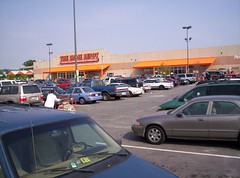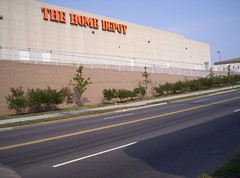Speaking of preservation and community advocacy
I am starting to figure out that some of my concerns about community advocacy and what I call neighborhood parochialism, have to do with "generational" differences amongst activists and city conditions, especially for issues like these:
-- occupation of alleys;
-- parking regulations generally
-- strategic and surgical density increases;
-- streetcars and transit.
From the early 1960s until about 2003, the key concern of community activists was neighborhood stabilization in the face of continued population decline, the decline of the quality, frequency, and competency of the provision of municipal services, and crime, coupled with a focus on automobility--urban focused but still within the broad development paradigm around the accommodation of the car and separation of uses.
See, even though people live in the city, they are imprinted with the dominant national land development paradigm of separation of uses, deconcentration, and the underutilization of land, coupled with the necessity of automobility connecting the widely dispersed activity centers and destinations.
So people move to the city, not recognizing that the way that they have been taught to consider land use is an inappropriate framework to use when considering urban land use decisions, especially in the parts of the city that were developed before 1920, as these areas were developed during the eras when people walked to work and other destinations (1800-1890), or took the streetcar (1890-1920).
NOTE: and people haven't figured out that rather than use suburban land use patterns for redeveloping parts of the city like the shopping center where Home Depot is (Rhode Island Place) or the new Giant Supermarket-anchored shopping center in Congress Heights in Ward 8, that these places should be redeveloped in a distinctly urban pattern, to extend the qualities that define the city, rather than remake the city over for the automobile, and continue patterns of de-densification.


Are you in the suburbs or in Washington, DC?
Another parallel thread was urban renewal, with very much an orientation to remaking the city over to accommodate automobility both in terms of retail and commercial areas, i.e., parking fronted strip shopping districts (H Street Connection, Nehemiah Center) and enclosed malls (Hechinger Mall, Georgetown Park), and housing--at least in places in Greater Capitol Hill, many alley areas were recreated as condominums accompanied by dedicated parking.
Today, even in the midst of the current housing downturn, demand for urban living is increasing, population of the city is rising. There is greater demand for mixed use development, and at the very least, people want more neighborhood serving retail, restaurants, and services.
In Washington, DC, more and more people ride transit, walk, or bicycle to work--and presumably on non-work trips than in any other city in the United States--except for New York City. ("We're number two, we're number two.")
But most of the neighborhood and city wide community organizations are led by people who came to prominence during the period when the city was shrinking in population, and fighting to maintain itself.
Now that the city is growing, and because DC is to begin with, a "city,"" it's absolutely necessary for people to recognize that land use decision making must:
1. Link land use and transportation planning going forward--they cannot and must not be separated;
2. Embrace mixed use;
3. Embrace better transit including streetcars, and think about accepting--at least on the intermediate term--an overhead catenary infrastructure to power streetcars;
4. Embrace surgically inserted density increases;
5. Probably should reconsider the height limit, if only to prevent the Central Business District from jumping the Union Station railyard and consuming those neighborhoods and light industrial areas--this is a particular problem for the Florida Market;
6. Change the zoning regulations to be pro-city and pro-urban rather than pro-car and pro-suburban;
7. Start penalizing car ownership through much higher charges for residential parking permits, car registration, with higher fees for additional cars in each household;
8. Make sure that zoning regulations de-emphasize the focus on accommodating automobiles.
Times change and civic leadership must recognize this and change when necessary. And it's imperative for the city's success going forward.
Labels: civic engagement, progressive urban political agenda, sustainable land use and resource planning, transportation planning, urban design/placemaking, urban economics, zoning



0 Comments:
Post a Comment
<< Home